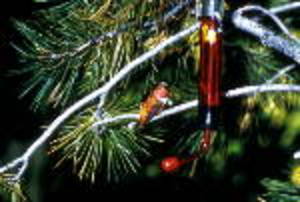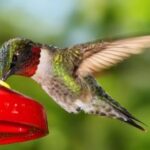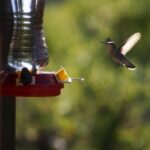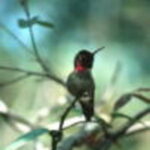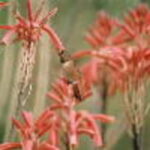Hummingbirds are generally found in larger populations in the southern states of these United States, but the northern state have these tiny, migrating birds visit them. Michigan is one of these states that have hummingbirds visit on the migration trek that they make each year. These tiny birds will begin arriving at feeders and hummingbird gardens in Michigan in April and will leave sometime between July and October.
There are five species of hummingbirds in Michigan; some of them are more commonly seen than others. These are the Ruby-throated Hummingbird, the Rufous Hummingbird, the Broad-billed Hummingbird, the Green Violet-eared Hummingbird and the White-eared Hummingbird. The Broad-billed Hummingbird and the Green Violet-eared Hummingbird are the least common species of hummingbirds in Michigan while the Ruby-throated Hummingbird is the most common.
While the majority of people who witness these tiny creatures do, their air acrobats while devouring the nectar provided in a hummingbird garden or in a feeder do not have the curiosity of exactly what species is being seen, there are always some people who will enjoy the knowledge of knowing what species they are watching. Identifying the hummingbirds in Michigan is easier to accomplish than in states where more species are present, but even with just five species documented, the task can be daunting at times. Of course, the most common species is often the easiest to identify. This would be the Ruby-throated Hummingbird who gets its name from the male’s ruby-red throat. Not only does the male Ruby-throated have a specific colored throat it also has a forked tail that is not generally found on any of the other species of hummingbirds in Michigan. Both sexes of Ruby-throated Hummingbirds have emerald colored backs and the female’s breast is white.
Identifying the Rufous Hummingbird is almost as easy as identifying the Ruby-throated Hummingbird in that this species of hummingbird has rufous colored feathers that cover a large portion of its body, thus giving it its name. The male has this non-iridescent rufous color on its crown, tail and sides while the female has it on her flanks and at the base of her tail. All Rufous Hummingbirds have white breasts and green wings.
The Broad-billed Hummingbird is best identified by its black tipped, bright red-orange bill that is a characteristic of both sexes. The male is also identified by its metallic blue throat and dark green breast, crown and back while the female has a throat and breast that are gray and the same green crown and back as the male. This species of hummingbird is rarely seen in Michigan, but has been documented several times.
The Green violet-eared Hummingbird is the largest hummingbird species ever documented in Michigan, with weights of between 5 and 6 grams. The males of this large hummingbird species have an iridescent blue-green throat and breast and have a violet colored patch that begins at its eye and travels almost to the beginning of its wing and on its neck. The female has the same iridescent coloring on her throat, but her breast is a more dull color with some bronzing. This is another rarely seen hummingbird species in Michigan, but well worth watching for.
The last species of hummingbirds to watch for in Michigan is the White-eared Hummingbird, which gets its name from white ear patch found on both sexes of the species. This white patch is actually a line of white feathers that forms a stripe behind the eye and down to almost its neck. Other features to watch for with this species are a red bill tipped with black. The male has metallic blue-green feathers on its chin, purple feathers on its crown and green feathers on the rest of its body. The female is less colorful, but identifiable all the same with its body that is spotted with white, golden green and turquoise feathers, a lighter belly area and a black stripe located behind the white ear patch.
Hummingbird gardens are becoming more popular throughout the other states and Michigan is no different. For a successful hummingbird garden, consider using these hummingbird approved plants:
Bleeding heart Butterfly weed Cardinal Flower
Columbines Coral Bells Day lily
Delphinium Fireweed Foxglove
Gay feather Hollyhocks Hosta
Honeysuckle Impatiens Jewelweed
Larkspur Liatris Liatris
Lilac Mexican sunflower Milkweed, Butterfly
Nasturtiums Obedient plant Plaintain lily
Red Morning Glory Red sage Salvia
Scarlet runner bean Scarlet sage Snapdragon
Soapwort Texas sage Tree tobacco
Zinnia
